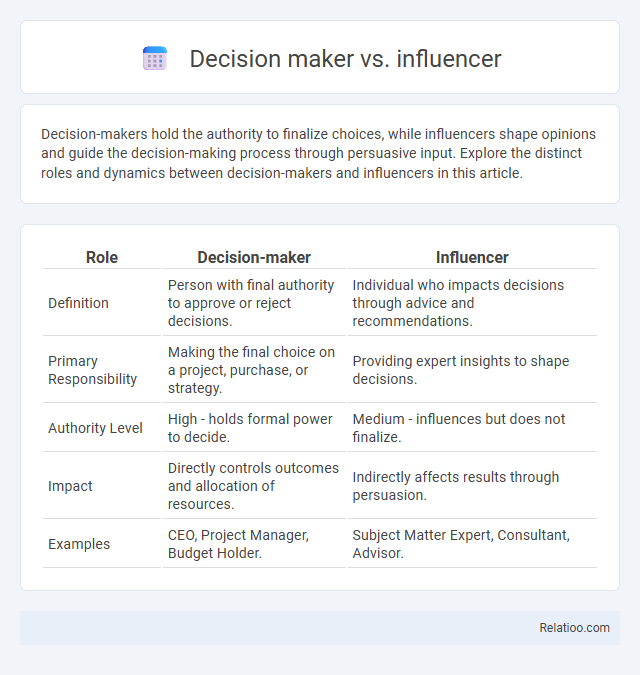Decision-makers hold the authority to finalize choices, while influencers shape opinions and guide the decision-making process through persuasive input. Explore the distinct roles and dynamics between decision-makers and influencers in this article.
Table of Comparison
| Role | Decision-maker | Influencer |
|---|---|---|
| Definition | Person with final authority to approve or reject decisions. | Individual who impacts decisions through advice and recommendations. |
| Primary Responsibility | Making the final choice on a project, purchase, or strategy. | Providing expert insights to shape decisions. |
| Authority Level | High - holds formal power to decide. | Medium - influences but does not finalize. |
| Impact | Directly controls outcomes and allocation of resources. | Indirectly affects results through persuasion. |
| Examples | CEO, Project Manager, Budget Holder. | Subject Matter Expert, Consultant, Advisor. |
Understanding Decision-Makers and Influencers
Decision-makers hold the authority to finalize purchases or strategic choices, while influencers impact these decisions by providing insights or expert opinions within the organization. Understanding decision-makers involves recognizing their power and motivations, whereas understanding influencers requires identifying who shapes the preferences and criteria leading to approval. You must map both roles to tailor communication strategies effectively and optimize decision outcomes.
Key Differences Between Decision-Makers and Influencers
Key differences between decision-makers and influencers revolve around their roles in the purchasing process. Decision-makers have the authority to approve or reject final decisions, while influencers shape opinions and provide input that impacts those decisions. Understanding how your influencers affect the decision-makers allows you to tailor strategies that effectively guide the buying journey.
Roles and Responsibilities in the Decision Process
Decision-makers hold the authority to approve or reject final decisions, driving the strategic direction and resource allocation within your organization. Influencers shape the decision-making process by providing expertise, insights, and recommendations that impact the options considered. Stakeholders, while not directly making decisions, actively contribute feedback and concerns to ensure decisions align with broader organizational goals and values.
Identifying Decision-Makers in Organizations
Identifying decision-makers in organizations involves distinguishing between decision-makers, influencers, and gatekeepers who each play specific roles in the purchasing process. Decision-makers have the authority to approve or reject purchases, while influencers provide input and shape opinions without final authority, and gatekeepers control access to decision-makers by managing information flow. Accurately mapping these roles through organizational charts, stakeholder analysis, and communication patterns is essential for targeted marketing and effective sales strategies.
Recognizing Influencers and Their Impact
Recognizing influencers involves identifying individuals who shape opinions and guide decision-makers through expert advice, recommendations, or social proof within an organization. Influencers impact purchasing decisions by providing critical information and swaying preferences without having the final authority to approve expenditures or contracts. Understanding the distinct roles of decision-makers and influencers enhances targeted marketing strategies, ensuring that messaging reaches those who truly affect the buying process and accelerates conversion rates.
Importance of Each Role in Business Outcomes
Decision-makers hold the ultimate authority to approve budgets and final strategies, directly impacting business success by ensuring resources align with organizational goals. Influencers shape preferences and perceptions through expert advice, market trends, and stakeholder feedback, significantly affecting the decisions made by those in authority. Understanding the balance between these roles helps Your business craft targeted communication and engagement strategies that optimize overall business outcomes.
Strategies to Engage Decision-Makers
Engaging decision-makers requires targeted strategies that emphasize clear value propositions and data-driven insights tailored to their specific business goals. Understanding the distinct roles of influencers--who shape opinions through expertise--and gatekeepers--who control access--is crucial for crafting personalized communications that resonate with your intended decision-makers. Your ability to identify and address the priorities of each stakeholder maximizes the effectiveness of your outreach and accelerates the decision-making process.
Effective Approaches to Win Over Influencers
Influencers hold a critical role in the buying process by shaping preferences and guiding decisions within organizations. Effective approaches to win over influencers involve understanding their specific needs, providing tailored content that addresses their pain points, and building trust through consistent, value-driven engagement. Leveraging social proof, expert endorsements, and personalized communication enhances the influence on their recommendations, ultimately impacting the final decision-maker's choice.
Decision-Maker vs Influencer: Common Misconceptions
Decision-makers hold the authority to approve final decisions, while influencers sway opinions and provide recommendations without formal authority. A common misconception is that influencers have decision-making power, but their role is limited to shaping perspectives through expertise, relationships, or information. Understanding this distinction is crucial for effective stakeholder engagement and targeted communication strategies.
Maximizing Success by Aligning with Both Roles
Maximizing success in business requires understanding the distinct roles of decision-makers and influencers, where decision-makers hold the authority to finalize choices, while influencers shape preferences and opinions throughout the purchasing process. Aligning strategies to engage both roles involves integrating insights from influencers to tailor persuasive messaging and providing decision-makers with clear, data-driven value propositions to facilitate confident choices. This dual alignment enhances conversion rates by addressing the needs and motivations of all key stakeholders in the decision-making ecosystem.

Infographic: Decision-maker vs Influencer
 relatioo.com
relatioo.com